Most Essential Conversion Rate Optimization Statistics And Trends For 2023
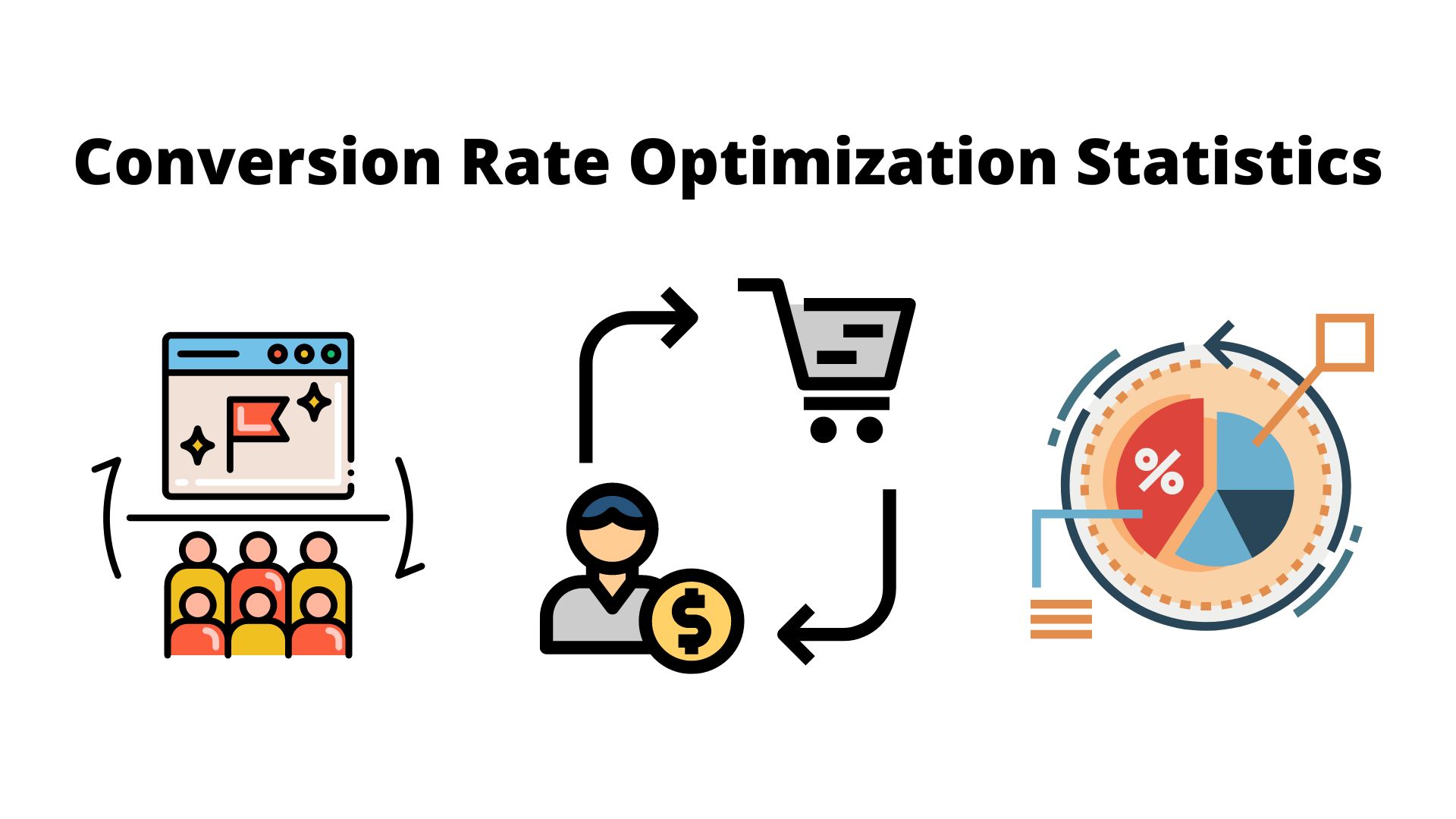
Page Contents
- Crucial Conversion Rate Optimization (CRO) Statistics (Editor’s Choice)
- Different Ways to Improve Conversion Rates for Your Business
- Conversion Rate Optimization Statistics by Device During The Holiday Season
- Conversion Rate Optimization Trends
- Conversion Rate Optimization Statistics by Online Shopping
- Conversion Rate by Traffic Source
- CRO Landing Page Optimization
- Conversion Rate Testing Statistics
- Website Conversion Rate Optimization Statistics
- Tips And Strategies To Boost CRO
- Conclusion
Conversion Rate Optimization Statistics: Converting traffic driven to the website into loyal paying consumers is a real-time issue for many traders. However, with the help of efficient conversion rate optimization (CRO), businesses might be able to achieve it. Experts say that even the slightest difference in conversion rate can affect businesses on the bottom line. A slight increase of 1 to 2% in conversion rate can boost the revenue twofold. Here, we have drafted a list of some crucial Conversion Rate Optimization statistics and trends that might help traders tweak their marketing strategy and gain the benefits of conversion rate optimization in the best way possible.
Crucial Conversion Rate Optimization (CRO) Statistics (Editor’s Choice)
- The conversion rate for a website averages 2.35%.
- According to CRO statistics, Google has a conversion rate of almost 8%.
- The creation of videos with conversion events has increased by 30%
- Legal services are the most popular service in the B2B space with a conversion rate of 7.4%.
- The average conversion rate for Facebook ads is 9.21%.
- According to a survey, 22% of businesses are unhappy with their conversion rates.
- Conversion rates are best attained when the load time is between 0 and 4 seconds.
- Nearly 74% of conversion rate optimization plans result in higher sales.
- Nearly 46.9% of optimizers conduct one to two tests per month.
- The conversion rate can be boosted by video content on landing pages up to 86%.
- The preponderance of conversion rate optimization (CRO) specialists falls within the early thirties age bracket.
- Specifically, more than 40% of professionals in the CRO field belong to the age group of 31 to 40 years old.
- CRO Statistics have shown that marketers can reduce their leads by making multiple offers via landing pages.
- This is a decrease of 266% according to CRO Statistics.
- A personalized call-to-action can increase conversion rates by up to 202%.
- The lowest eCommerce conversion rate per industry is for sporting goods.
- Paid search has the highest conversion rate of any traffic source.
- In 2026, the global market for conversion rate optimization software is expected to reach $1.932 million.
Different Ways to Improve Conversion Rates for Your Business
- Create reminder emails for abandoned carts.
- Automate processes to improve conversion.
- Perform A/B Testing.
- Offer generous discounts.
- Provide exceptional customer service.
- Add a live chat option on the landing page
- Examine how people behave and react on your website
- Improve the purchase process.
- Add multiple payment options.
- Make changes according to customer’s requirements.
- Optimize website for mobile phones.
Conversion Rate Optimization Statistics by Device During The Holiday Season
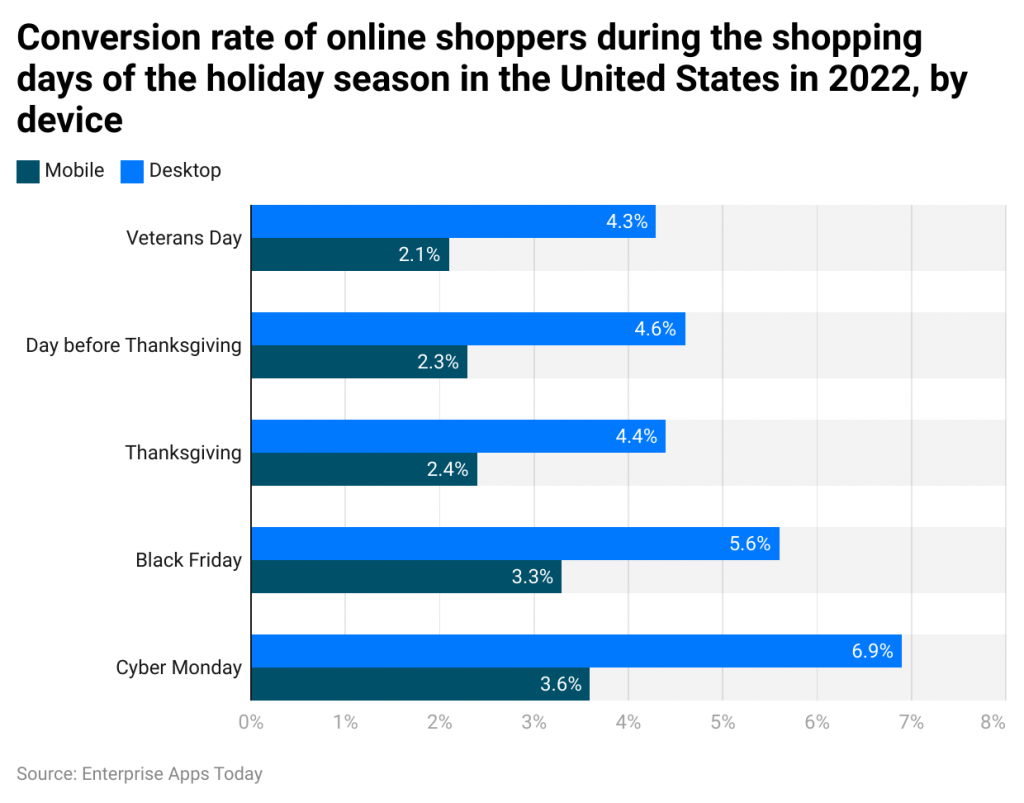 (Source: statista.com)
(Source: statista.com)
As of 2022, Conversion rate Optimization Statistics showed that in the United States of America, consumers are more likely to use desktops for shopping instead of mobile devices. During the holiday seasons, Cyber Monday was the top-rated season for having the highest conversion rate on any given website.
Conversion Rate Optimization Trends
#1. The global eCommerce conversion rate rests at 2.17 percent
In the second quarter of 2019, only 2.58 percent of worldwide online website visits converted into purchases. Although e-commerce businesses are trying to boost their revenue and page views, traditional shopping is still quite a popular choice for many customers.
#2. The average website conversion rate is 2.35 percent across all industries
This figure varies from website to website. If the conversion rate is reaching 2 to 3 percent, it means the business is on the flourishing side.
#3. The catering and food industry has the highest rate of conversion at 18.2 percent
The conversion rate of the media and entertainment industry stands at 18.1 percent, the finance and insurance industry has a 15.1 percent conversion rate, the legal industry has a 14.5 percent conversion rate, the education industry has a 14.2 percent, and the fitness and nutrition industry has a 13.2 percent conversion rate.
#4. In the business-to-business scenario, legal services have the highest conversion rate of 7.4 percent
As per conversion rate optimization stats, legal services account for the highest B2B lead conversion rate. POS (Point of sales services) has the second-best average conversion rate.
Conversion Rate Optimization Statistics by Online Shopping
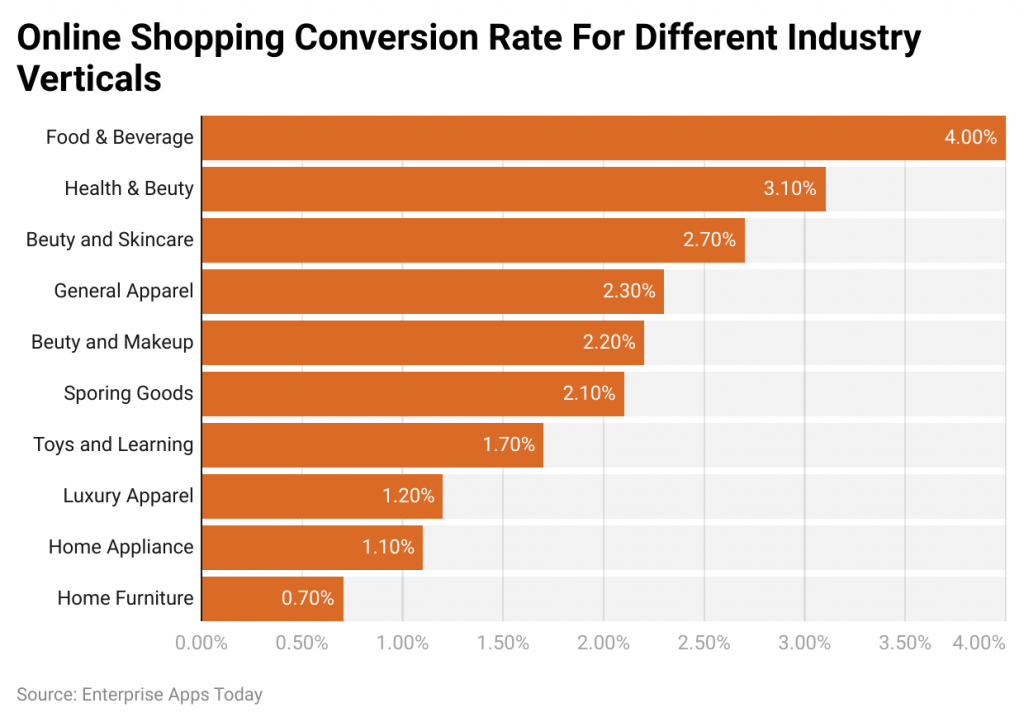 (Source: meetanshi.com)
(Source: meetanshi.com)
The top three product categories in which the highest conversion rate is observed are Food and Beverage (4%), Health and Beauty (3.10%), and Beauty and Skincare (2.40%). According to Conversion Rate Optimization statistics, the lowest conversion is observed for the home furniture category (0.70%).
Conversion Rate by Traffic Source
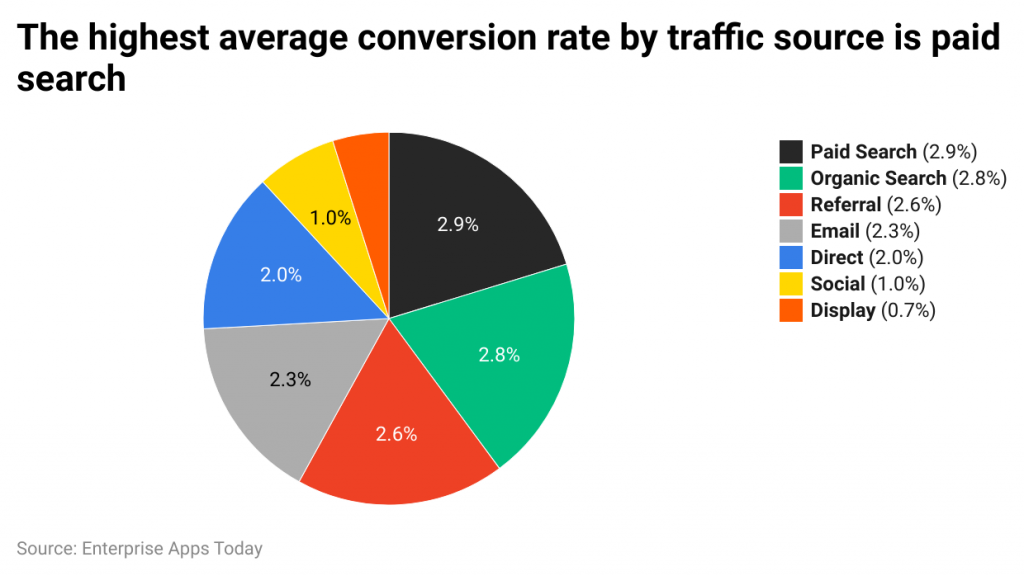 (Source: startupbonsai.com)
(Source: startupbonsai.com)
According to research, on average highest conversion rate is generated through paid search resulting in 2.9%, followed by organic search (2.8%) and referrals (2.6%). Display marketing strategy contributes only up to 0.7% in converting people into customers.
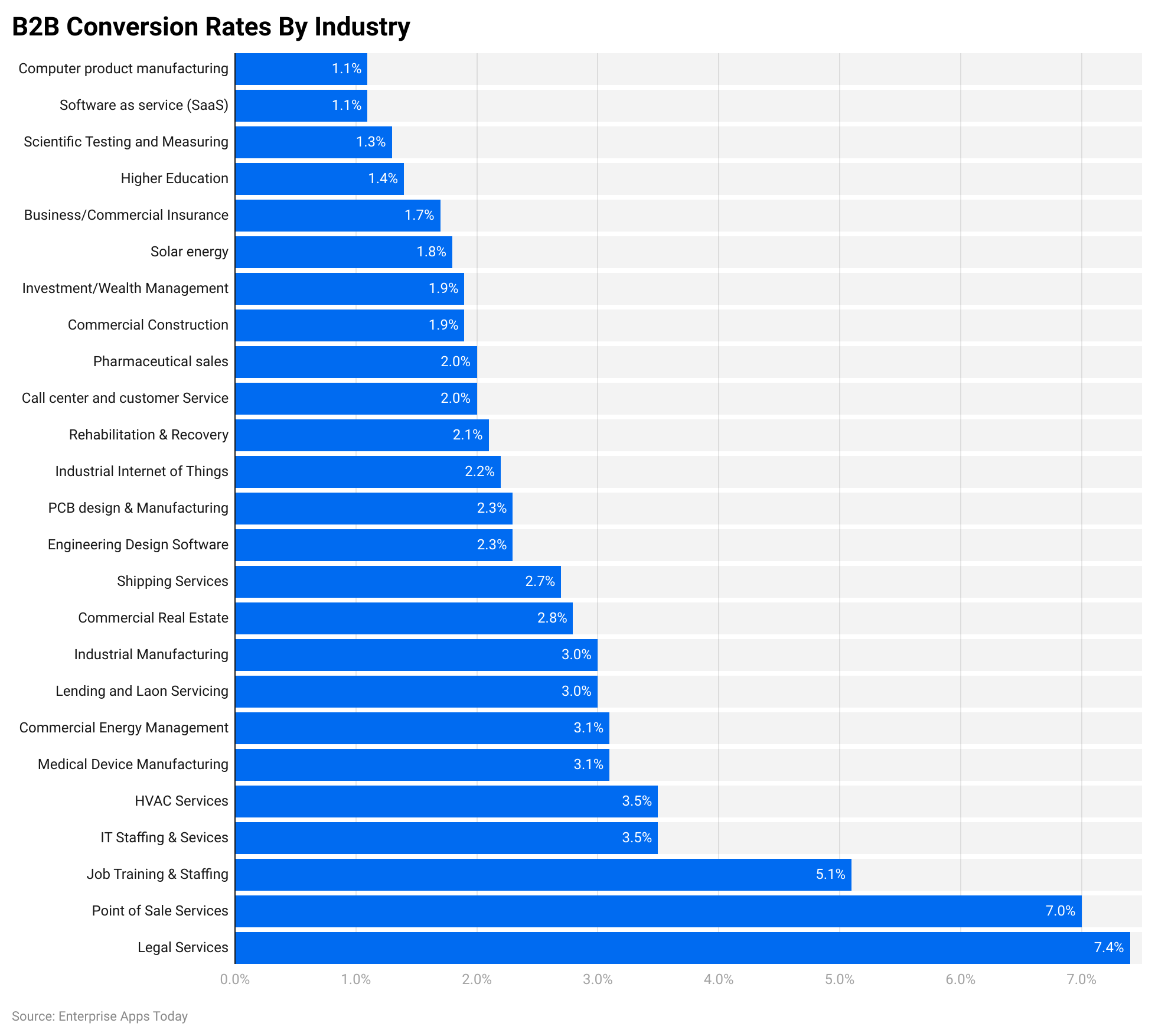
(Source: FirstPageSage)
#5. Facebook ads account for an average conversion rate of 9.21 percent
Facebook ads have four times more success in converting traffic into paying customers as compared to other websites.

(Source: Wordstream)
#6. Mobile eCommerce conversion rate is as low as 1.81 percent
The Mobile e-commerce rate shows that traders need to focus on developing apps if they want to please their consumers. As per the conversion rate optimization statistics, the average eCommerce conversion rate of desktops was recorded at 1.98 percent in 2020.
#7. Google has an average eCommerce conversion rate of 8.2 percent
With the usage of multiple channels, Google has been able to achieve an average conversion rate of 8.2 percent. It shows that search engines are leading in the list of conversion scales.
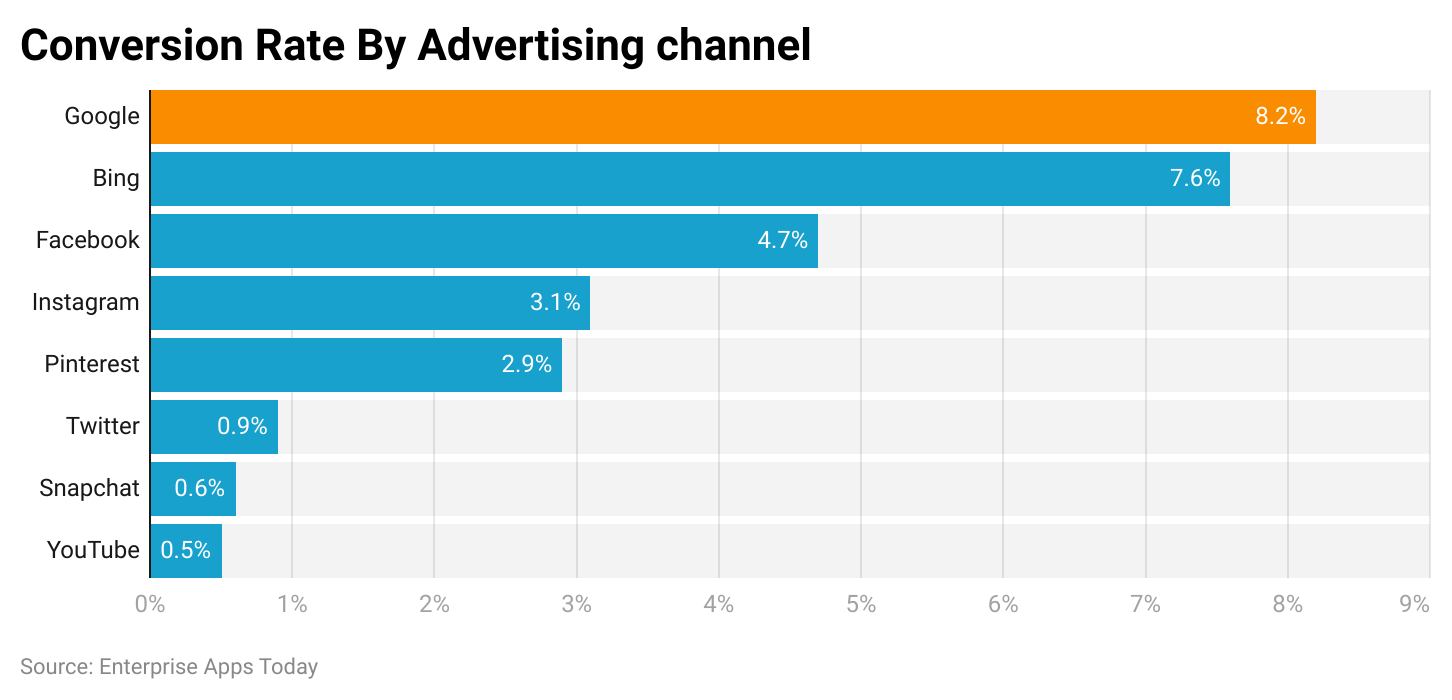
(Source: Forbes)
#8. The usage of artificial intelligence (AI) by traders has improved by 190 percent in the last two years
AI-related tools have become quite prominent in the fields of conversion and optimization. From 2019 to 2020, the usage of AI has gone up by 190 percent among businesses.
#9. Facebook fitness ads account for a 14.9 percent conversion rate
Social media conversion statistics show Facebook has a massive average conversion rate of 9.21 percent. Fitness ads posted on the platform have a conversion rate as high as 14.9 percent.
#10. Web analytical tools are frequently implemented to boost conversions
The adoption rate of web analytical tools stands at 69 percent. Nearly 64 percent of traders use user experience testing, 61 percent of them use personalization, and 57 percent of them perform content testing as part of their CRO strategy.
#11. Instagram has a conversion rate of 4.5 percent with user-produced content
As per the latest CRO statistics, user-created content on Instagram has a much greater conversion rate. Instagram remains a much more convenient channel for attracting sales as long as traders rely on users to do advertising.
#12. The average ROI for marketers who use CRO tools is 223 percent
The latest CRO statistics show that only 5 percent of 3000 surveyed traders have reported no ROI, whereas 173 of them have said that they have recorded higher than 1000 percent ROI.
#13. The average loading time after the majority of visitor runoff from a website is less than 2 seconds
Website conversion rate stats show how important user experience is for potential customers. Loading time is one of the most crucial factors that decide whether a conversion is going to take place or not.
#14. Only 39.6 percent of trades have a documented CRO plan in place.
CRO statistics show that only one out of five traders has reported not having a CRO strategy at all. Around 39.3 percent of them have said that they do have a CRO plan but it is not structured in any way.
#15. Around 68 percent of small firms do not follow any CRO plan
CRO stats show that around two-thirds of small companies do not follow any CRO plan.
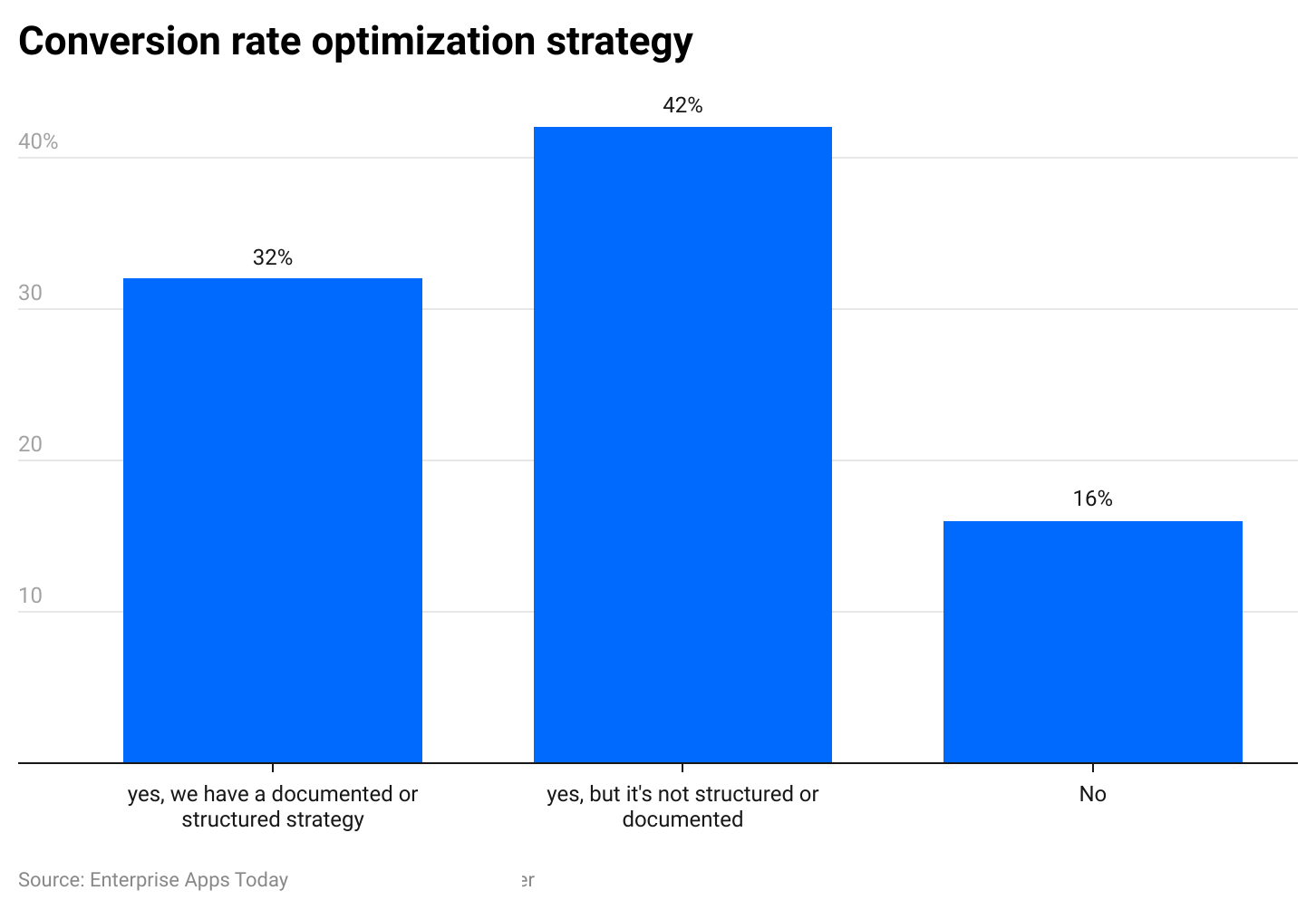
(Source: CXL Institute)
#16. 85 percent of traders do not pay much attention to getting customers back to their websites
Sales conversion rate statistics show that most traders are not paying much attention to winning over hard-to-get consumers who need multiple visits before they become paying customers. Traders need to come with up an innovative plan to promote their products in a much better way.
#17. 82 percent of marketers think that it is hard to learn how to run and test conversion rates efficiently
Conversion rate optimization statistics show that nearly eight out of 10 traders find it hard to perform CRO efficiently.
#18. With the usage of CRO, Leading traders are able to convert 52 out of every 100 target contacts
CRO statistics reveal that around half of businesses contact their prospective consumers constantly before selling them their products or services. Only 8 percent of sales take place with one target contact and more than 48 percent of sales happen from four to ten target contacts.
#19. Nearly 74 percent of conversion rate optimization plans lead to greater sales
The latest CRO facts indicate that businesses that have properly structured CRO strategies witness a major boost in their sales. As CRO plans lead to phenomenal outcomes in 74 percent of cases, it is advisable to pay more attention to getting higher revenue in three out of four episodes.
#20. 22 percent of traders are not happy with their conversion rates
CRO stats say that 22 percent of firms are not satisfied with their conversions as they do not understand that the average conversion rate drifts at nearly 3 percent and it varies across different types of industries.
CRO Landing Page Optimization
#21. Around 50 percent of traders create a new landing page for each of their advertising campaign
Around 48 percent of marketers depend on a new landing page as they launch a new advertising campaign. For such businesses, having the best practices in presenting new and fresh content to consumers has been proven quite beneficial in improving conversions.
#22. Showcasing videos on the landing page can improve conversion rates by 86 percent
Around 87 percent of businesses are relying on video content to boost their conversions. Posting videos on landing pages can make conversion rates grow faster.
#23. Increasing the number of landing pages from 10 to 15 can boost leads by 55 percent
It shows that making new landing pages for each marketing campaign might be a beneficial practice. Firms that have an increased number of landing pages can convert much of their traffic into leads.
#24. Removing navigation from the landing page can increase the conversion rate by 100 percent
The latest landing page conversion stats show that the top elements on the landing page should be specifically designed to lead customers to do a single action, anything additional will be a distraction for them. Page navigation often distracts customers from doing the desired action.
#25. Websites that have more than 40 landing pages generate 1200 percent more leads
Firms that are more liberal in creating multiple landing pages usually receive 1200 percent more leads.
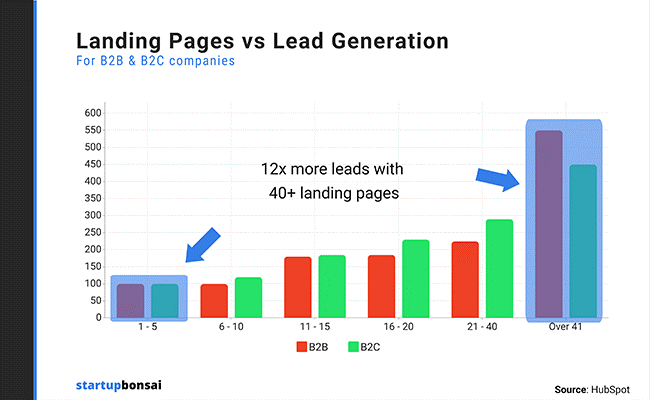
(Source: HubSpot)
#26. Changing the call-to-action (CTA) to the ‘Click here' button improves conversion rates by 30 percent
CTA buttons or using the ‘submit' button as a CTA anchor test can reduce conversion rates by 3 percent. Using the ‘click here' button or ‘go' button can increase conversion rates by 30 percent and 25 percent respectively.
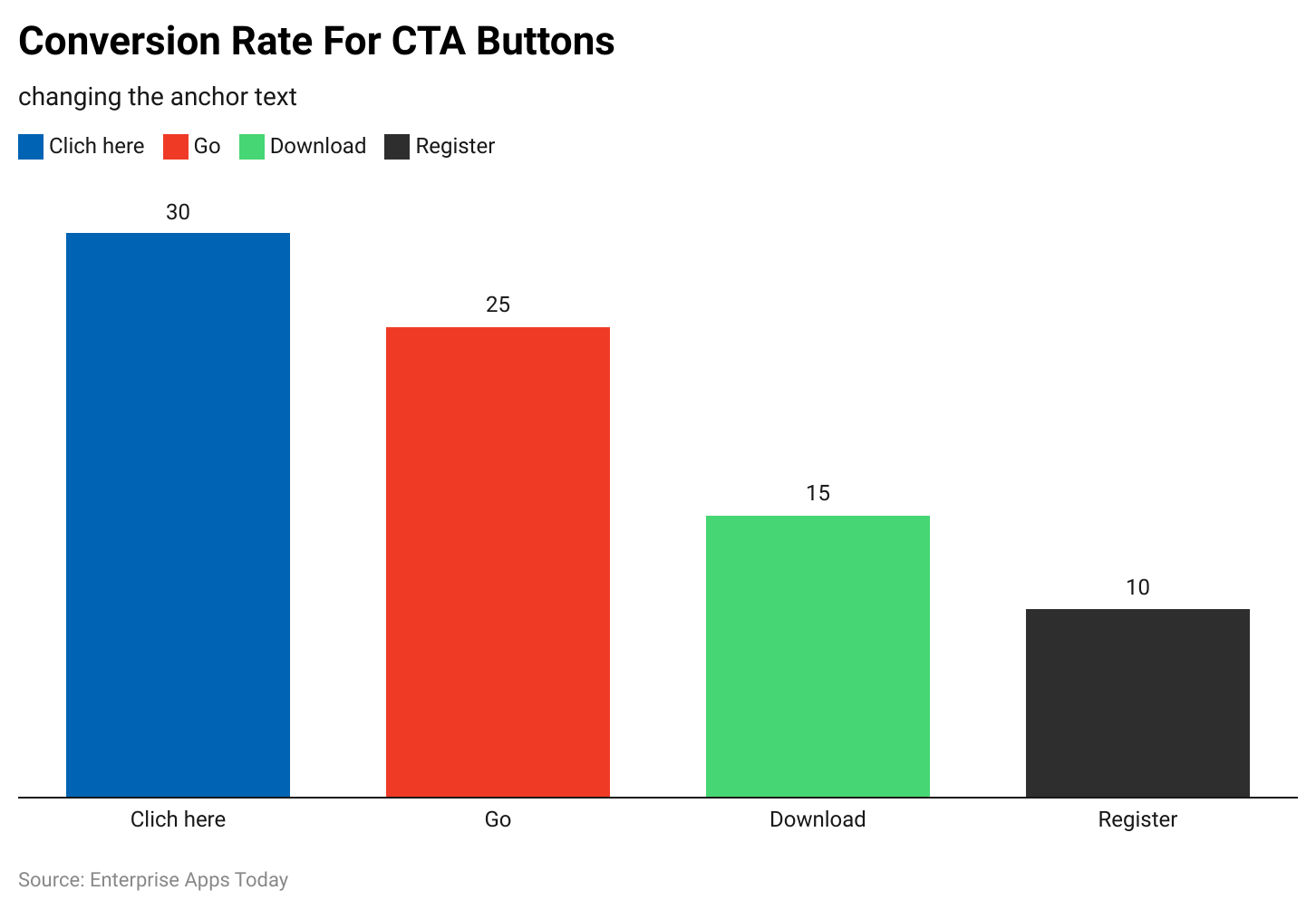
(Source: Unbounce)
#27. Nearly 62 percent of B2B trades have fewer than 6 landing pages
Despite many advantages of having multiple landing pages, 62 percent of B2B trades still have only six landing pages.
#28. Decreasing the number of form fields from 11 to 4 can lead to 120 percent more conversions
Businesses can attract more conversions by reducing the number of form fields as minimum as possible.
#29. Forms asking for visitors' contact numbers can lessen conversion rates by 48 percent
Sites that ask for visitors' contact numbers can witness a 5 to 48 percent drop in conversion rates. Most customers do not like to give away their phone numbers and take this practice as a violation of their privacy.
#30. Around 44 percent of B2B clicks land on homepages rather than landing pages
CRO statistics show that 44 percent of B2B trades do not bother to have landing pages for their advertising campaigns rather they choose to drive traffic on their homepage. In this strategy, it is hard to get any conversion as homepages do not convert, and due to many navigations landing pages as well do not convert well.
#31. Landing pages that do not ask visitors' age witness 3 percent higher conversion rates
Landing pages that ask visitors to share their age details affect conversion rates in a negative way. Many consumers treat it as an intrusion of their privacy.
#32. Making many offers on the landing page can diminish leads by 266 percent
Including several offers on the landing page is not good for conversions. Landing pages will get 266 percent fewer leads as compared to landing pages with just one single offer.
#33. 61 percent of firms test their landing pages more than five times each month
A/B testing seems to be one of the most popular forms of CRO testing and it is used by nearly 56 percent of businesses now these days.
#34. Marketing automation improves competent leads by 451 percent
Many studies have shown that using marketing automation tools can foster potential leads to a 451 percent increase in qualified leads.
#35. Longer landing pages can result in 220 percent more leads as compared to shorter landing pages
CRO statistics show that landing pages that include more information further down perform better as compared to shorter landing pages.
Conversion Rate Testing Statistics
#36. More than 56 percent of traders use A/B testing to boost their conversions
Currently, it is the most preferred CRO method among marketers.
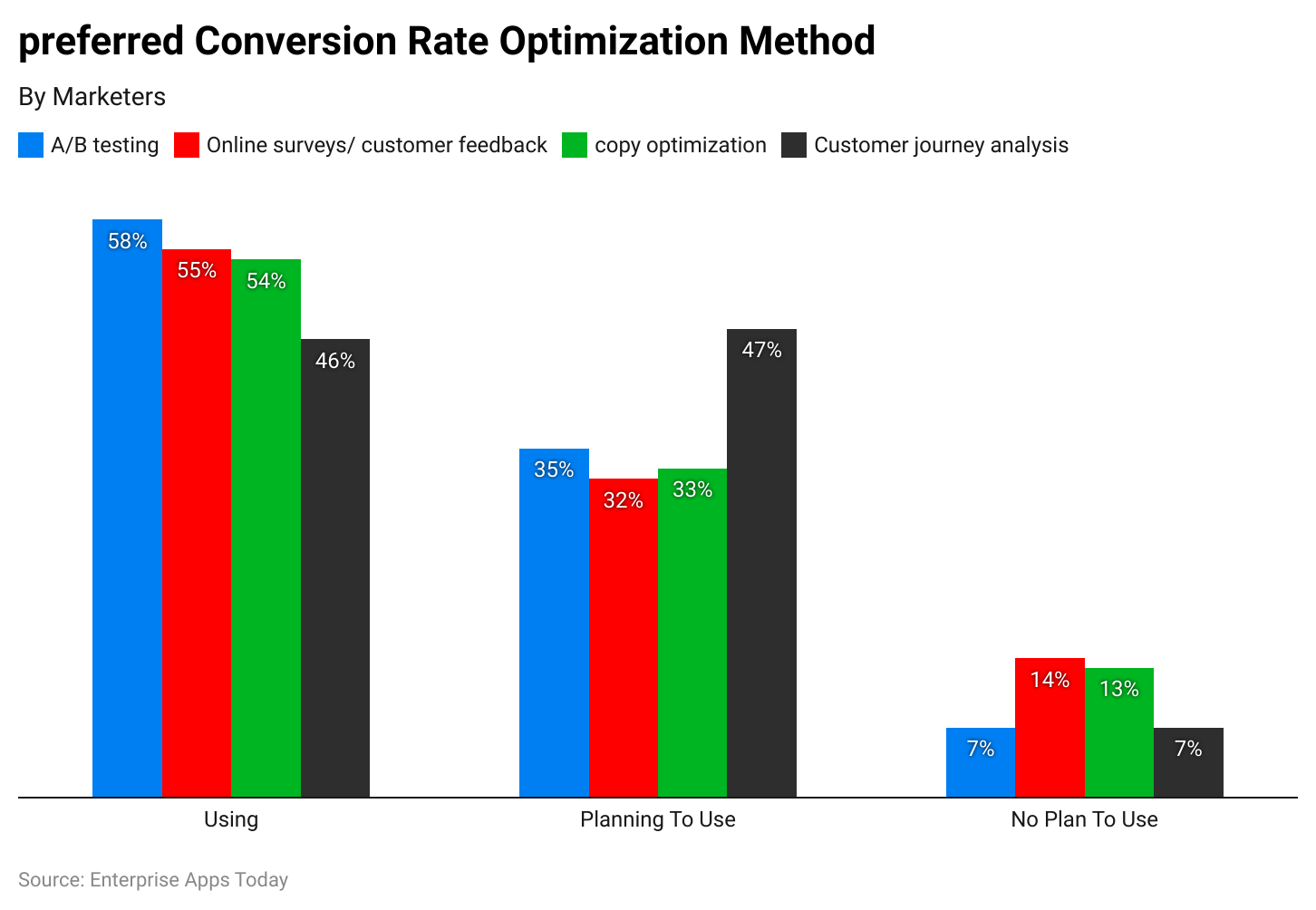
(Source: Econsultancy)
#37. 52 percent of firms that have landing pages use A/B testing to improve conversions
More than half of firms that have landing pages perform CR tests regularly to boost conversion rates.
#38. Most businesses try to avoid multi-page testing due to its difficulty level
Testing multiple landing pages at the same time is quite effective and considered an advanced method. However, most traders find it quite a complex task.
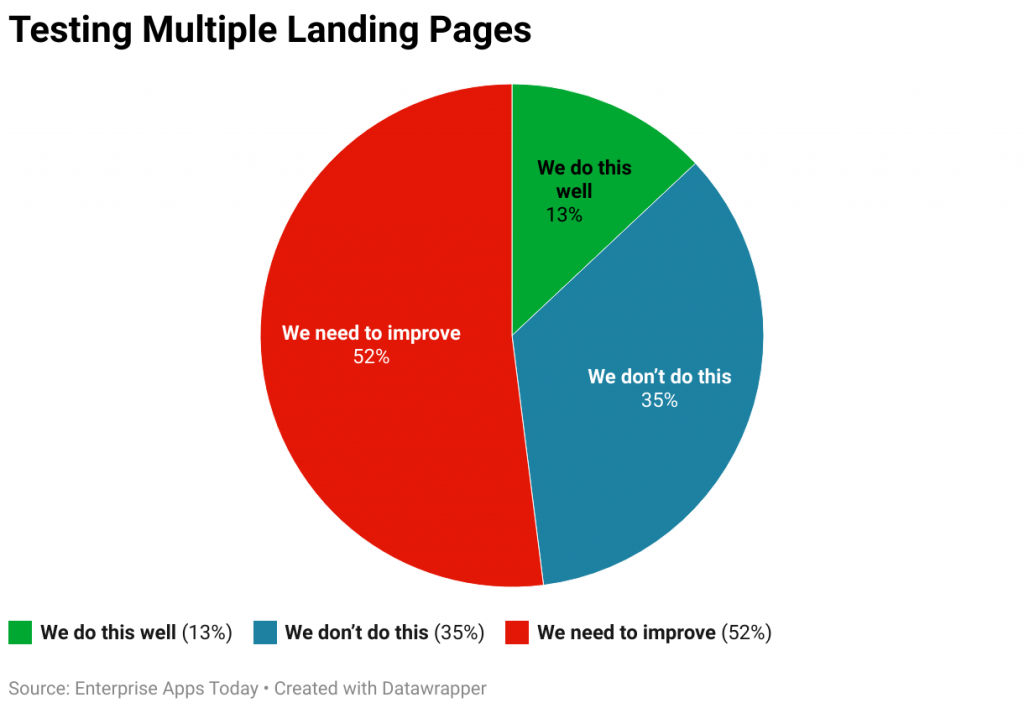
(Source: Unbounce)
#40. Businesses that are able to achieve improved conversions are more like to perform 50 percent more CR tests.
Website Conversion Rate Optimization Statistics
#41. Traders who use optimization software usually have an average conversion rate of 30 percent
CRO stats indicate that a solid landing page strategy to optimize potential customers' experience is more efficient in leveraging the average lead conversion rate as compared to a typical A/B test.
#42. The media and entertainment industry accounts for the highest form-fill landing page conversion rate
As per the latest CRO facts, form-filling kind of landing pages are best for the media and entertainment industry.
#43. Dividing the number of sales to qualified leads is the best way to track the lead conversion rate
Around 35 percent of businesses opt for the same method to calculate their lead conversion rate.
#44. About 57 percent of traders believe that web development is the most effective function in CRO
Most companies believe that the best web development firms or their in-house IT teams play a major role in optimizing conversions.
#45. Experts say that a personalized sales call within two days of making contact can boost the conversion rate by more than 200 percent.
Tips And Strategies To Boost CRO
#46. Personalized CTAs are 42 percent better than non-personalized CTAs
Personalization has emerged as one of the most popular trends in modern-day marketing. Personalizing CTAs can fetch 42 percent more traffic. Personalized CTAs can lead to 202 percent higher conversions.
#47. Anchor text CTAs are 121 percent better than button CTAs
A study has revealed that a well-written text link is more proficient as compared to button CTAs.
#48. Personalized email messages lead to 10 percent more conversions
Along with personalized CTAs, personalized email messages can significantly elevate conversion rates by 10 percent.
#49. Slow-loading pages can trim down conversion rates by 7 percent
Experts reveal that just a 1-second delay in site loading can affect conversion rates by 7 percent.
#50. The travel industry has the greatest referral conversion rate at 9.5 percent
Referral marketing execution can make businesses reach new heights as it works as a customer acquisition channel that can result in high conversions.
#51. Emails with one CTA are able to boost sales by up to 1617 percent
Marketers need to focus on just one CTA to elevate average email conversion rates. Implementing this practice and improving clicks by 371 percent and sales up to 1617 percent.
#52. User-generated content can increase conversion rates by 161 percent across all industries.

(Source: startup bonsai)
#53. Nearly 76 percent of business leaders believe that improving digital experience can affect conversions majorly.
#54. To-converting firms invest at least 5 percent of their marketing budget on conversion rate optimization (CRO).
#55. 55.5 percent of firms have plans to increase their CRO budget.
Conclusion
Conversion rate optimization (CRO) can aid traders in obtaining greater sales, improved turnover, and reduced customer acquisition costs. Optimization of the visitor conversion process on websites or mobile apps has become a very popular tool that helps traders build their profitable online ventures. Several big ventures are ready to spend big bucks to hire CRO experts, while small businesses are still relying on trial and error. These conversion rate optimization (CRO) facts offer an depth understanding of the conversion rate optimization (CRO) process and some useful insights to those who want to implement CRO in their marketing strategies.
FAQ.
Conversion Rate Optimization (CRO) is a method that is used to boost visitors on websites or mobile apps who go on to take a pre-determined action and can be potential buyers in the future.
Conversion Rate Optimization (CRO) ensures that marketers have the highest number of people visiting their websites or mobile apps to do the tasks businesses have set for them. Many websites aim at having people purchase their products or services; this is known as macro-conversion. However, there are many types of conversions before macro-conversion takes place such as signing up for newsletters
Obtaining more and more visitors on websites or mobile apps is not enough for the business to flourish; it needs the right kind of people connected to it. Conversion rate optimization (CRO) helps find the right kind of customers for the business with the help of SEO.
A better user experience, stronger reliance, enhanced ROI, greater scalability, and improved customer insights are some of the direct benefits of conversion rate optimization (CRO).
Examining, implementing, testing, and verifying are four essential steps of the conversion rate optimization (CRO) process.
Conversion rate optimization (CRO) can also be called conversion funnel optimization.

Barry is a lover of everything technology. Figuring out how the software works and creating content to shed more light on the value it offers users is his favorite pastime. When not evaluating apps or programs, he's busy trying out new healthy recipes, doing yoga, meditating, or taking nature walks with his little one.